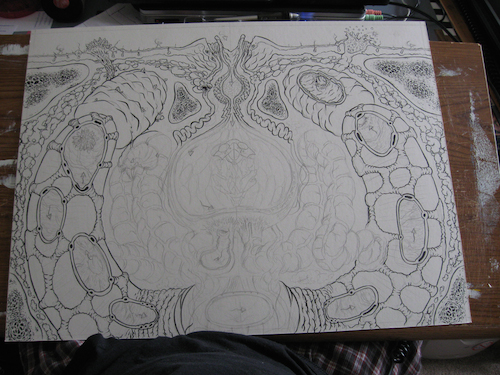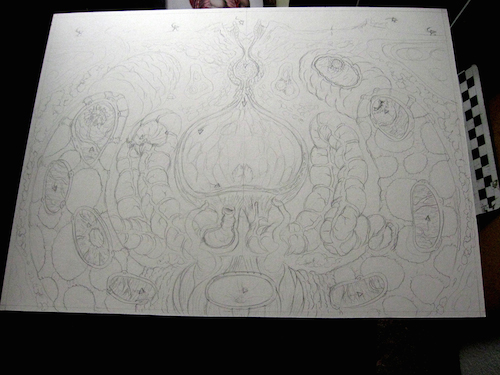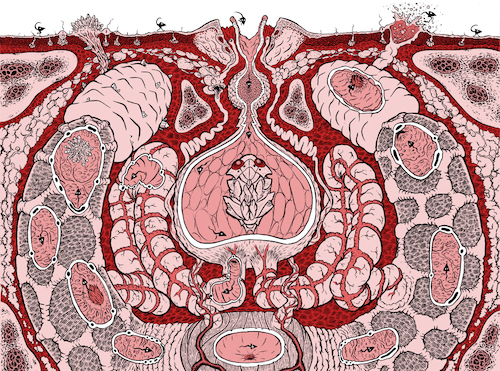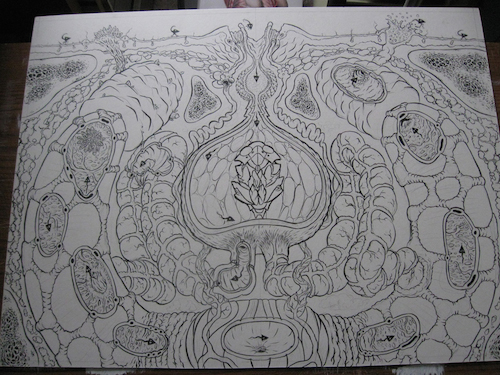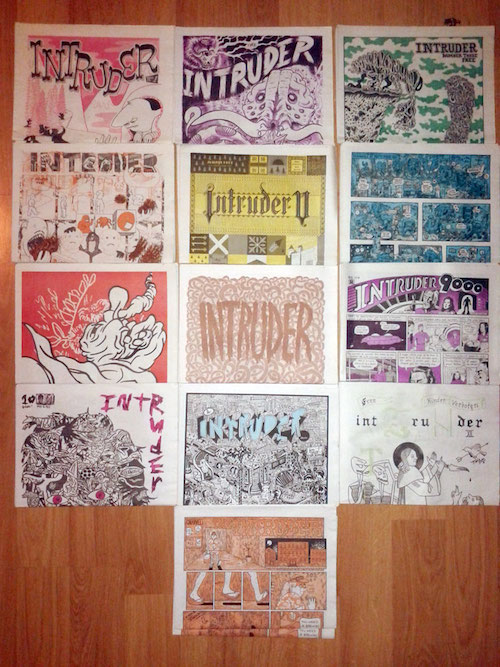Visual Arts Jake Uitti — December 8, 2014 11:30 — 0 Comments
Intruder Comics with Marc J. Palm
Marc J. Palm is one of the many talented comic artists in Seattle. He also has a special place in my heart because he’s been working on a secret Monarch project. In the mean time, I wanted to talk with Marc about Intruder Comics, a Seattle-based “party zone” that puts out a free, quarterly, co-op, comics newspaper. Intruder began in March of 2012 and consists of 16 Seattle-based, “darkly comedic cartoonists,” according to their Facebook page.Â
Jake Uitti: For someone who doesn’t know about Intruder Comics, what’s the ONE THING you hope they learn and remember forever?
Marc J. Palm: It would be important for people to understand that there are hard working cartoonists in Seattle who are serious about making them available to people in print.
JU: I’m interested in this idea of a hard working cartoonist. Take me behind the curtain – what’s a day in the life of a hard working comic you know?
MJP: I cannot speak for everyone, but I know that most of us have 40 hrs/week day jobs that make it so that we can create comics in our free time. In that free time, when we’re making comics, we’re in it deep. There’s a drive to create that cannot be calculated or really understood. It’s an obsessive desire to make lots of tiny drawings with lots of tiny lines.
There are some of us who draw a bunch of panels, cut them up, xerox them, paste down the parts they like, draw on top of that, repeat until as satisfied as they can be by the deadline. Then there are some who write pages of story and dialog, draw rough versions of the comic page until it reads or looks good enough, then they’ll do a final penciled version a page, put that on a light table and on another piece of paper they’ll ink over the pencil drawing, then maybe put watercolor on top of that, or scan the black and white line work and meticulously color everything in the computer.
To do one page of a comic can take several hours, maybe days. That may sound crazy, but one must compare it to making a movie. The artist has to write the comic, edit it themselves, come up with sets, costumes, actors, special effects, then rehearse (sketching/penciling), shoot the action, record the sounds (fill in sound effects/word balloons), then process it so that it can be translated to some outlet (internet/print), market and distribute. We do it ourselves so that we have final say every step of the way. We’re confident that what we made will ideally make ourselves happy and maybe find an accepting audience.
JU: What about you, specifically. Can you show off anything (in this interview) that you’ve been working on? Maybe from sketch to final project?
MJP:Â Here’s a short series of process images for the spread I did in the first issue. And then a group shot of all 13 issues.
JU: Were you a part of Short Run? How did that go?
MJP: I’ve enthusiastically involved with Short Run from the beginning (4 years) and it’s always great! Best fest I’ve been to. We move a lot of Intruders since many of the contributors have them at their own tables where they’re selling prints and comics.
I don’t know what I like most, the customers who are curious and eager to buy new, interesting booklets and art or the folks behind the table who are excited to be there, trade and party? That can feel like a family reunion when you only get to see folks from Portland or LA once or twice a year.
I usually do really well as far as sales and then I just pour that back into the floor, buying what I cannot trade people for. The last two years have been so overwhelming that I can only make it through half of the room before exhausting my wallet or my mind.
JU: What do you wish Seattle did better in terms of fostering its cartoonists?
MJP: I think Seattle is killing it right now. There are so many drawing groups and events like Short Run and this new underground show called Exterminator City. There’s a lot going on so if you’re a cartoonist and want to get involved, there are lots of options and it won’t be that hard to find info about them. It’s not like it was when I first got involved. Which was only by accident really. If Kurt Geissel hadn’t told me that Jim Woodring had a drawing night at the Cafe Racer one day I might not be where I’m at today.
I think that with the Stranger handing out Genius awards to cartoonists like Ellen Forney, Woodring and comic publishers like Gary Groth. There will be more interest and attention to alternative comics in Seattle. It would be nice, to go further, to see more comics in publications or in galleries, too.
JU: Last question: can you tell me what Intruder Comics is, exactly, and how you got involved and what Intruder is up to these days?
MJP: Intruder comics is a comic anthology in a tabloid newspaper format with a page count of 16 – 20. It’s comprised of a network of really talented people who all know one another. We do not accept submissions. It’s invite only. There are no ugly advertisements, so everyone including me pays for the paper to be printed. It’s a co-op situation and every contributor gets 100 copies for each page they turn in. The rest of the run, may it be 3,000 or 4,000 copies get distributed via subscribers or at comic fests, comic book stores, various other cafes and stores throughout Seattle. We even get them down to Olympia, Portland and LA.
I’ve organized and put together the paper from the beginning and have become the curator as well. Some of the original contributors moved out of state or do not participate as often any more. That led me to seek out local cartoonists who can consistently fit in with the loose but apparent tone that evolved when we started putting this out in 2012. Intruder is dark, really sick and twisted at times. It can be quirky and cute too, but not auto-bio cute. It’s hard to define it, but it’s obvious that our senses of humor are a bit raunchy or on the black comedy side of things. As it states on most covers…”No Kids!”
We just finished our 13th issue (fifth for 2014) and we’re gonna wait until February to release #14. We have plans to have it debut at the Linework comic fest in Portland and at an art show at the Push/Pull gallery/studio in Greenwood. Other than planning out when to release the next issue we don’t have many plans to change the paper. I’ve always felt that this should stay consistent and dependable. That is what I’m trying to do as the organizer. I’d like to see it stay a black and white paper with two colors on the cover for a long time. The idea of having it go full color or get much bigger doesn’t appeal to me. That can be another project which I encourage someone to do. We’re already inspiring the folks at the Neoglyphic Media to create their own tabloid comic paper.
The answer isn't poetry, but rather language
- Richard Kenney
